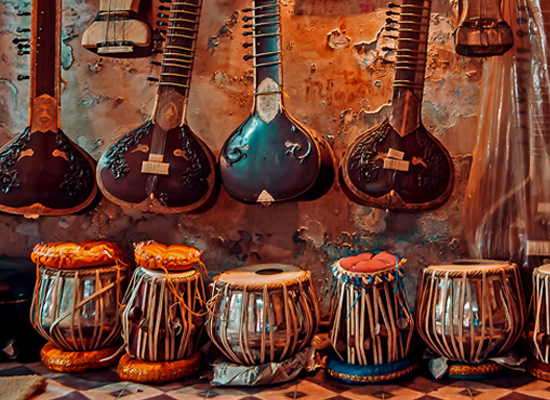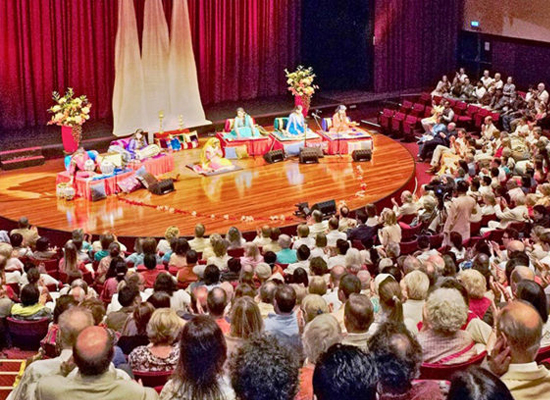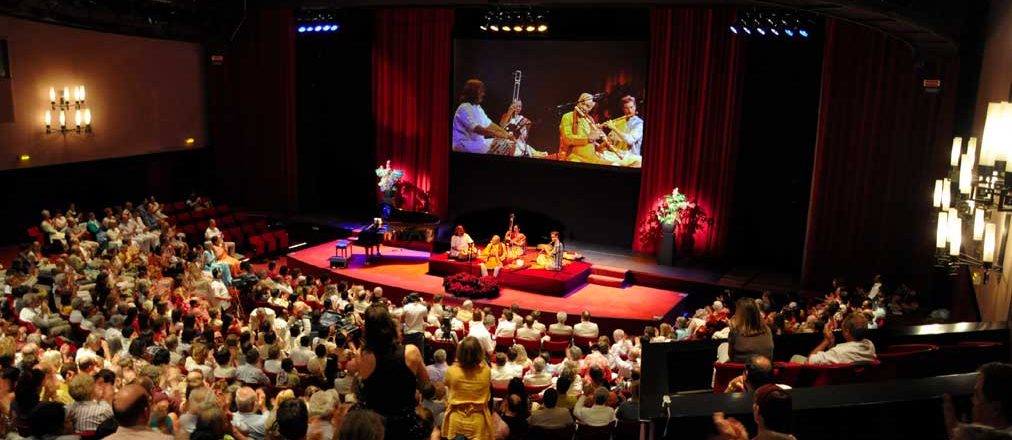The traditional music of the ancient Vedic civilization of India was called Gandharva Veda. It is still played today as the classical music of India.
Veda means pure knowledge, dharva means vibration, and gan is a sound that expresses the full range of life. Thus the art and science of music, Gandharva Veda, encompasses the pure knowledge of vibration of all of life.
Gandharva Veda is also related to Ayurveda, the Vedic branch of physiology, health, and medicine. Gandharva texts describe the link between music and health, and they prescribe particular ragas or melodies to create a state of balance and well-being in the listener’s physiology and in the environment.
The revival and restoration of Gandharva Veda

Renowned sitarist Reshma Srivastava
In 1986, TM Founder Maharishi Mahesh Yogi inspired a revival of Indian classical music by reconnecting it to its ancient origins in the dynamics of consciousness expressed in the Veda. This restoration is known as Maharishi Gandharva VedaSM music.
According to the Vedic tradition, matter is an expression of sound, and sound is a manifestation of the deep laws of nature that emerge from the pure, unbounded field of consciousness at the source of the phenomenal world. The supreme value of music is achieved when it gives expression to that pure, transcendental level of all life, the total value of life.
Maharishi described Gandharva Veda music in this way:
From morning to morning the melody of nature is changing. Gandharva music goes with the time, setting its melodies according to the changing nature. It sets forth those very natural melodies, which match with the process of evolution. It provides a powerful harmonizing influence in the whole atmosphere to balance imbalances in nature. —Maharishi Mahesh Yogi
Today, musicians from India are touring the world to perform Maharishi Gandharva Veda music and re-enliven the profound Vedic heritage of this ancient music. To help them more fully express the transcendental level of life, these musicians practice the TM technique to directly experience and explore the inner field of consciousness. On that foundation, they practice and perform Maharishi Gandharva Veda music as a Consciousness-BasedSM technology for creating balance, wholeness, health, and peace.
Resonance with nature’s cycles and rhythms

The great musical seers of the Vedic tradition perceived the vibrational cycles at the basis of nature
The great musical seers of the ancient Vedic tradition intuitively perceived the subtle rhythms and vibrational cycles at the basis of nature’s functioning. They understood that the physiology and environment resonate in synchrony with sound.
The Vedic texts describe numerous ragas—musical pieces based on particular scales, micro-tunings, melodies, rhythms, musical forms, compositional structures, and improvisational techniques. These may be played at specific times of day or seasonally to produce a powerful harmonizing and integrating influence on the physiology and environment.
The chart below illustrates the time theory of Gandharva Veda. The purpose of time-specific ragas is to match them with the rhythm and vibrational sequence of the cycles of the day and night. There are also ragas that are played at different seasons of the year, or for specific conditions, such as rain. All of them are designed to bring waves of harmony and bliss to the listener and environment.

Listening to Maharishi Gandharva Veda music

You may listen to Maharishi Gandharva Veda music sitting or lying down, with eyes open or closed
For maximum benefit, it is recommended to listen to Maharishi Gandharva Veda music without distractions, sitting comfortably or lying down. The eyes may be open or closed, as you wish.
A raga may be played up to an hour before or after the recommended time in the chart. Since these cycles are gradual and depend on the seasons, latitude, and other factors, the given times are not meant to be strict. The three-hour time periods correspond to the changing frequencies of nature at that time of day. These periods follow the cycle of sunlight rather than the clock.
Maharishi Gandharva Veda music may even be played in our home or workplace while we are away, to generate a peaceful, soothing atmosphere that uplifts the whole environment.
Global Maharishi Gandharva Veda online concerts
Online Maharishi Gandharva Veda concerts sponsored by the Academy of Arts for Enlightenment are offered on a regular basis for the enjoyment of listeners around the world. For more information and a schedule of upcoming concerts, visit the Academy’s Maharishi Gandharva Music pages.
You can also browse the selection of Maharishi Gandharva Veda music in the Enjoy TM store.
“Gandharva music is the eternal music of Nature, the melody of Nature eternally the same, going on and on and on in swings of bliss everywhere.” —Maharishi Mahesh Yogi
Note
1. Maharishi Gandharva-Ved: Creating Balance in Nature and Harmony in World Consciousness, Fairfield, Iowa: MIU Press, 1991




RELATED TOPICS
Other
Maharishi Mahesh Yogi on the Nature of Music and the Role of the Musician
This TM Talk features highlights of TM Founder Maharishi Mahesh Yogi speaking about why we are attracted to music and how it expresses the creative intelligence of nature.Other
Meditate America
This concert to benefit healthcare workers and others was hosted by the David Lynch Foundation and featured performances by Sting, Angélique Kidjo, Graham Nash, Elvis Costello, Kesha, Jim James, and the Brooklyn Youth Chorus.Music for Life—Music As Vibrating Consciousness
Acclaimed Italian violinist Alessandra Cuffaro talks about music as a representation of the essence of life—vibrating consciousness.
Music to Create Balance and Harmony in the World
Enjoy the Academy of Arts for Enlightenment's online Maharishi Gandharva VedaSM concerts with renowned sitarist Reshma Srivastava.